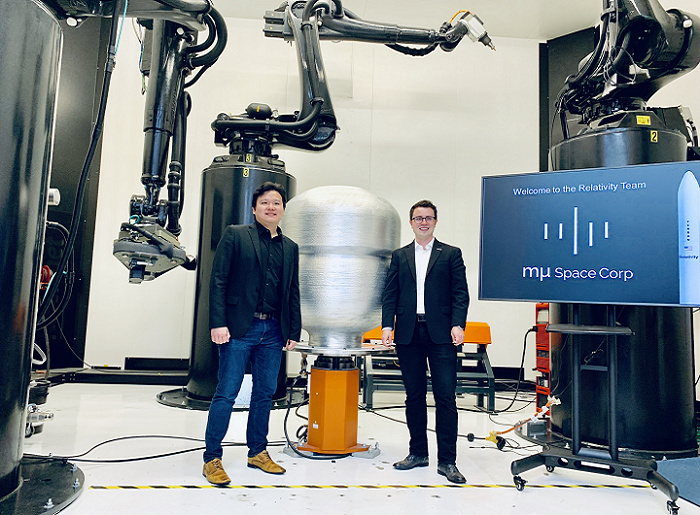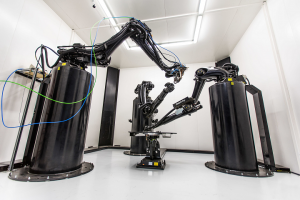Relativity Partners with mu Space, with Plans to Launch 3D Printed Terran 1 Rocket into Low Earth Orbit
3D printed rocket manufacturer Relativity Space, based in Los Angeles and backed by VC funding, signed its first public, multi-year commercial contract with satellite services vendor Telesat earlier this month. Now the company, which has grown from from 14 to 83 employees in the last year, has announced its second deal, this time with Thai satellite and space technology company mu Space. Together, the two will launch a satellite on Relativity’s Terran 1 rocket to Low Earth Orbit (LEO).
The Terran 1, which features a flexible architecture, was fabricated using Relativity’s patented technology platform on its giant Stargate 3D printer, which features 18-foot-tall robotic arms that use lasers to melt metal wire and can help lower the part count of a typical rocket from 100,000 to just 1,000. By utilizing Relativity’s technology in this new aerospace partnership, mu Space can achieve a faster, less expensive, and more reliable launch, which will help usher in a transformation in the satellite launch and services industry in the US and Asia-Pacific.
“mu Space is accelerating space technology development in Asia, and we consider the moon as the next explorable body in space beyond Earth. Relativity has the vision, team, and technology to deliver exceptional advantages in launching mu Space’s payloads, and supporting our goal of creating an interplanetary society in the future,” said mu Space’s CEO and Founder James Yenbamroong.
mu Space was founded just two years ago in Thailand, and is on a mission to lead the development of space technology, as well as encourage new space investments in the APAC region. The company is also working on developing both LEO and Geosynchronous Earth Orbit (GEO) satellite and space technologies that can hopefully increase the adoption of Internet of Things (IoT) devices in smart cities. With plans to launch its own satellite in 2021, mu Space’s LEO satellite will launch on the Terran 1 rocket in 2022 as a primary, dedicated payload.
“We’re excited to partner with mu Space, a disruptive innovator in the Asia-Pacific region, to launch their satellite and space technologies with our 3D printed Terran 1 rocket. We look forward to collaborating to strengthen the U.S. and Asia-Pacific space economy, and to advancing the future of humanity in space together with James and the entire mu Space team,” stated Tim Ellis, CEO and Co-Founder of Relativity.

L-r: mu Space CEO & Founder James Yenbamroong and Relativity Space CEO & Founder Tim Ellis stand in front of Relativity’s metal Stargate 3D printer – the largest of its kind.
Relativity, which is the first autonomous rocket factory and launch services leader for satellite constellations, has big plans to build humanity’s future in space, focusing first on rockets. Its unique platform vertically integrates 3D autonomous metal manufacturing technology, machine learning, software, and intelligent robotics to rapidly build 3D printed rockets, like the Terran 1, which will be the first rocket launched by the startup. Because the Terran 1 has far less parts and a simpler supply chain than traditional rockets, Relativity plans to build the flight-ready rocket, from raw material, in less than 60 days.
 The startup is expanding its infrastructure by fourfold this year, with over 350,000 square feet of launch, operations, production, and testing facilities; this last includes securing a polar orbit-capable launch site. Adding to its list of major government partnerships, which includes membership on the National Space Council that advises the White House and a two-decade, exclusive-use Commercial Space Launch Act (CSLA) agreement at the NASA Stennis Space Center E4 test complex, Relativity recently became the first VC-backed company to gain a launch site Right of Entry from the US Air Force at Cape Canaveral Launch Complex-16.
The startup is expanding its infrastructure by fourfold this year, with over 350,000 square feet of launch, operations, production, and testing facilities; this last includes securing a polar orbit-capable launch site. Adding to its list of major government partnerships, which includes membership on the National Space Council that advises the White House and a two-decade, exclusive-use Commercial Space Launch Act (CSLA) agreement at the NASA Stennis Space Center E4 test complex, Relativity recently became the first VC-backed company to gain a launch site Right of Entry from the US Air Force at Cape Canaveral Launch Complex-16.
Relativity’s new partnership with mu Space solidifies its growing leadership in the global satellite launch services industry, and also expands the shared vision between the two companies of building the future of the human race beyond our planet – mu Space wants to keep developing space technologies for safer lunar missions in order enable a moon settlement in the next decade, while Relativity wants to 3D print the first rocket on Mars and build an interplanetary society.
The first orbital test launch of Relativity’s Terran 1 rocket is currently on track to take place at the end of the year 2020.
Discuss this story and other 3D printing topics at 3DPrintBoard.com or share your thoughts in the Facebook comments below.
[Images: Relativity Space]Subscribe to Our Email Newsletter
Stay up-to-date on all the latest news from the 3D printing industry and receive information and offers from third party vendors.
You May Also Like
3D Printing News Briefs, April 13, 2024: Robotics, Orthotics, & Hypersonics
In 3D Printing News Briefs today, we’re focusing first on robotics, as Carnegie Mellon University’s new Robotics Innovation Center will house several community outreach programs, and Ugogo3D is now working...
Rail Giant Alstom Saves $15M with 3D Printing Automation Software 3D Spark
3D Spark has entered into a three-year deal with the rail giant Alstom. Alstom, a transport behemoth with annual revenues of $16 billion, specializes in the manufacture of trains, trams,...
Meltio Expands Global Reach with New Partnerships in the Americas and Europe
Spanish 3D printing manufacturer Meltio has expanded its sales network across the globe. With the addition of three new partners in the United States, Brazil, Argentina, and Italy, Meltio aims...
3D Printing Webinar and Event Roundup: April 7, 2024
Webinars and events in the 3D printing industry are picking back up this week! Sea-Air-Space is coming to Maryland, and SAE International is sponsoring a 3D Systems webinar about 3D...

































